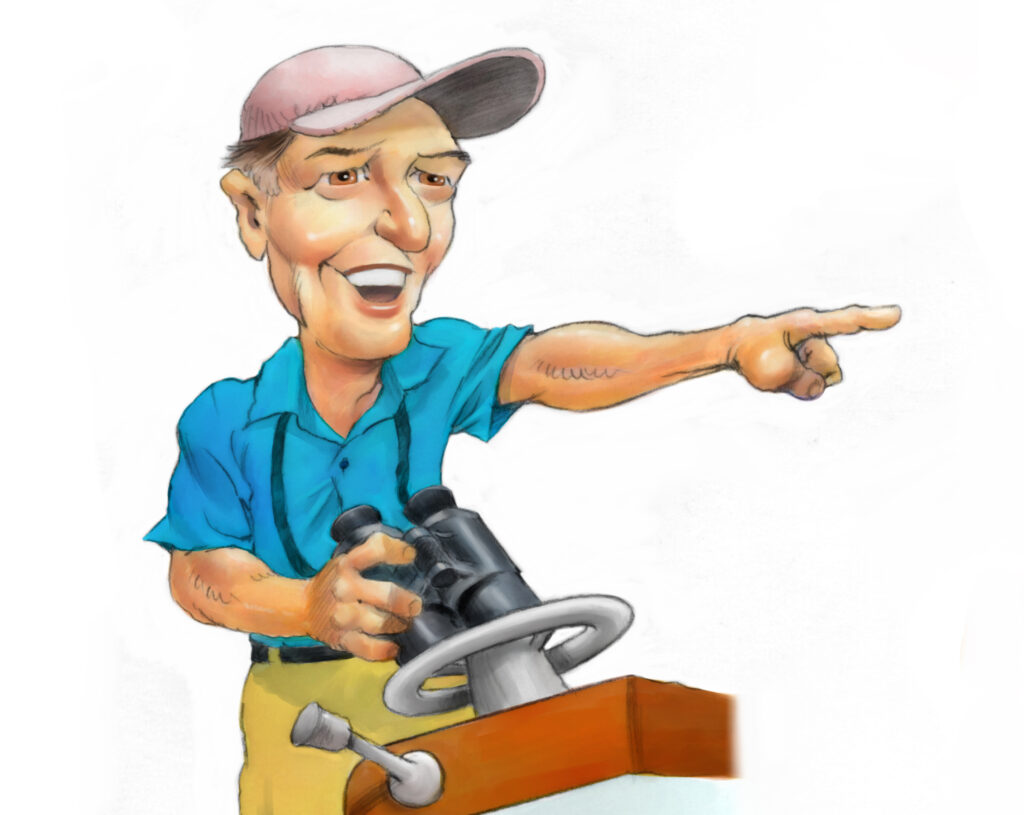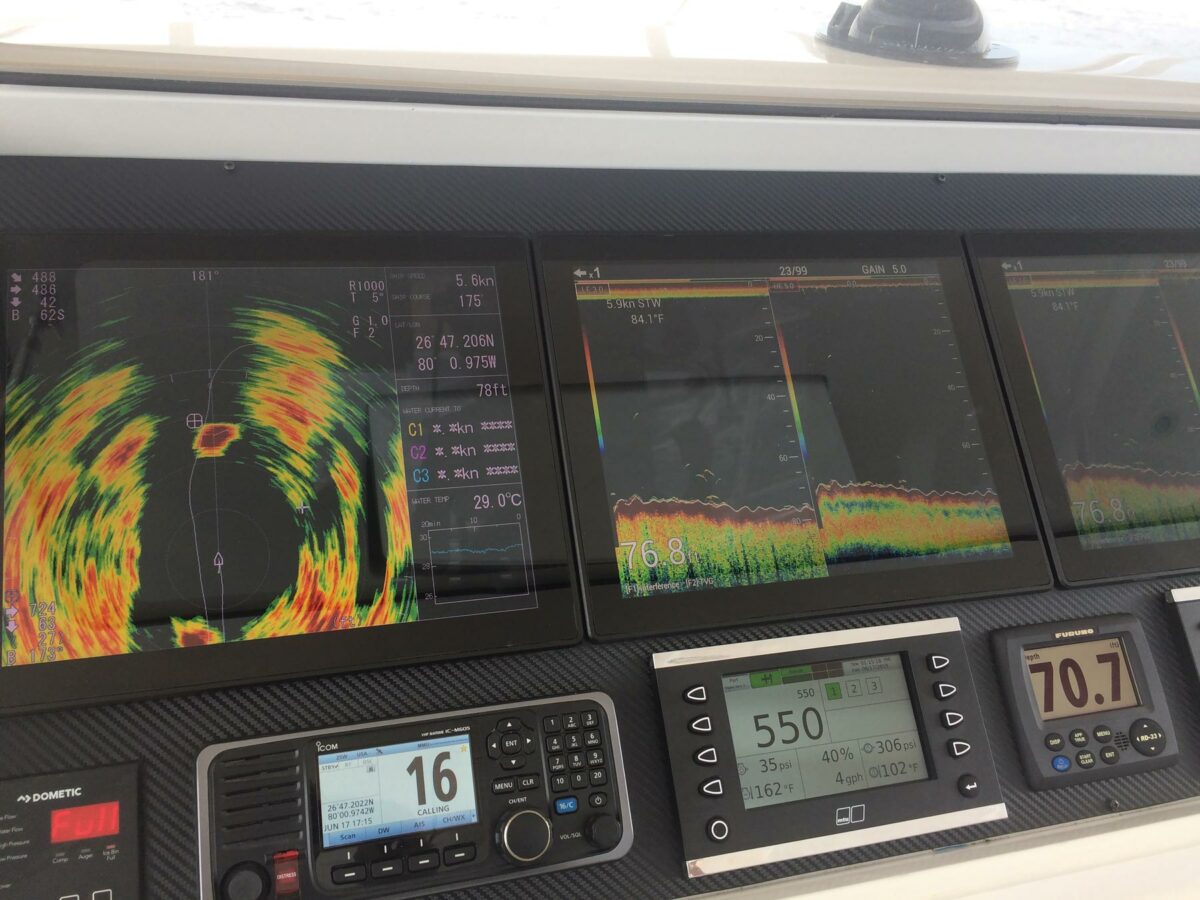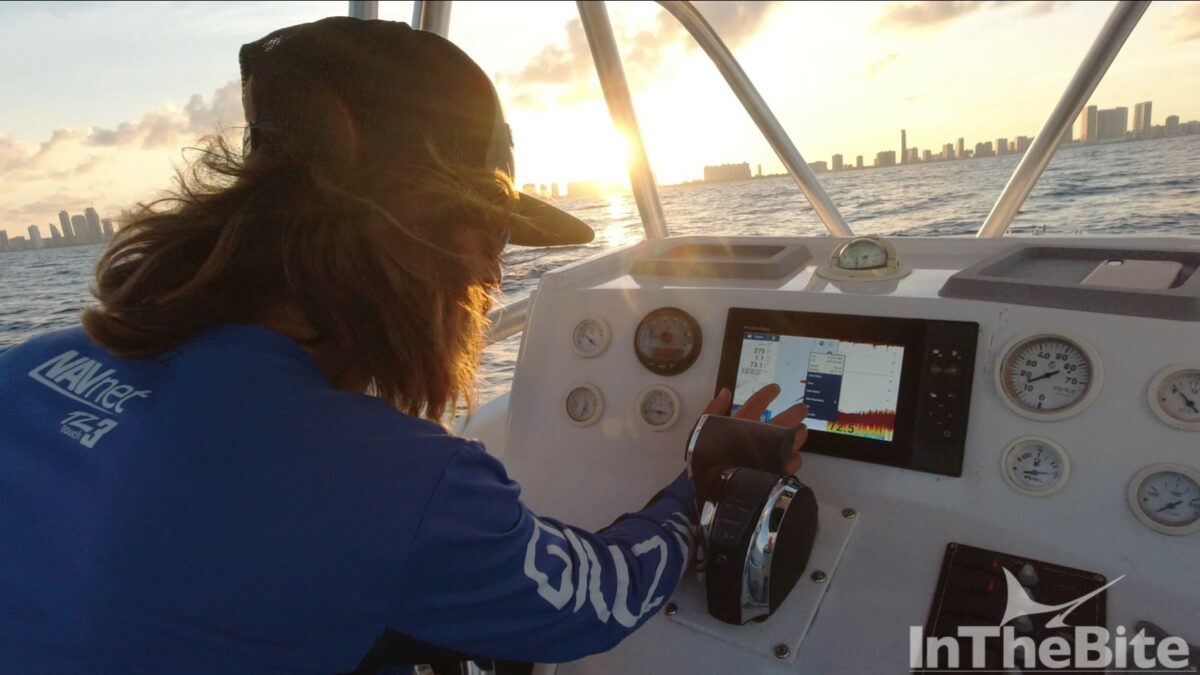Table of Contents
It was standing room only at a National Marine Electronics Association educational session about sonars. Professionals from around the world came to learn about the latest equipment and trends. Presenters included: Furuno, the most popular sonar in sportfishing; Kongsberg Maritime (Simrad Norway — not the same as Navico’s Simrad brand) spoke about their new Simrad SY50 Omni sonar; Koden, a longtime Japanese commercial fishing equipment manufacturer discussed their products; and Atlantic Marine Electronics (AME), a subsidiary of Viking Yachts, shared their experience from installing over 100 sportfish sonars.
We learned a lot during that round table seminar. Whether a new marine electronics dealer or a seasoned professional, we walked away with information to share with our customers. Here are some of the highlights.
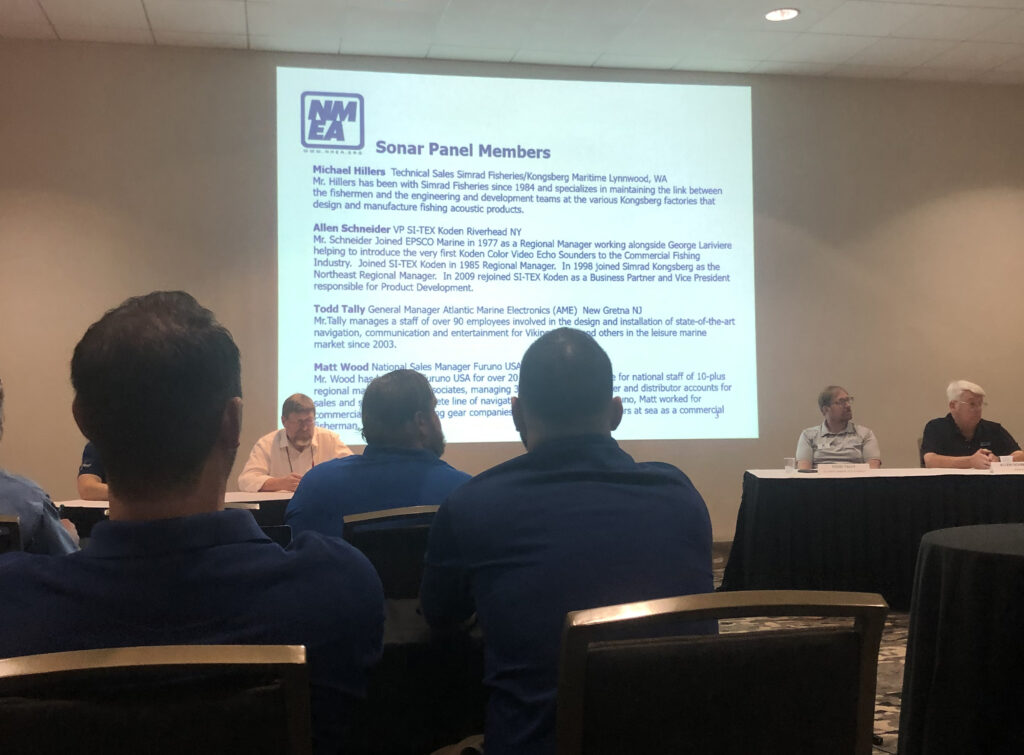
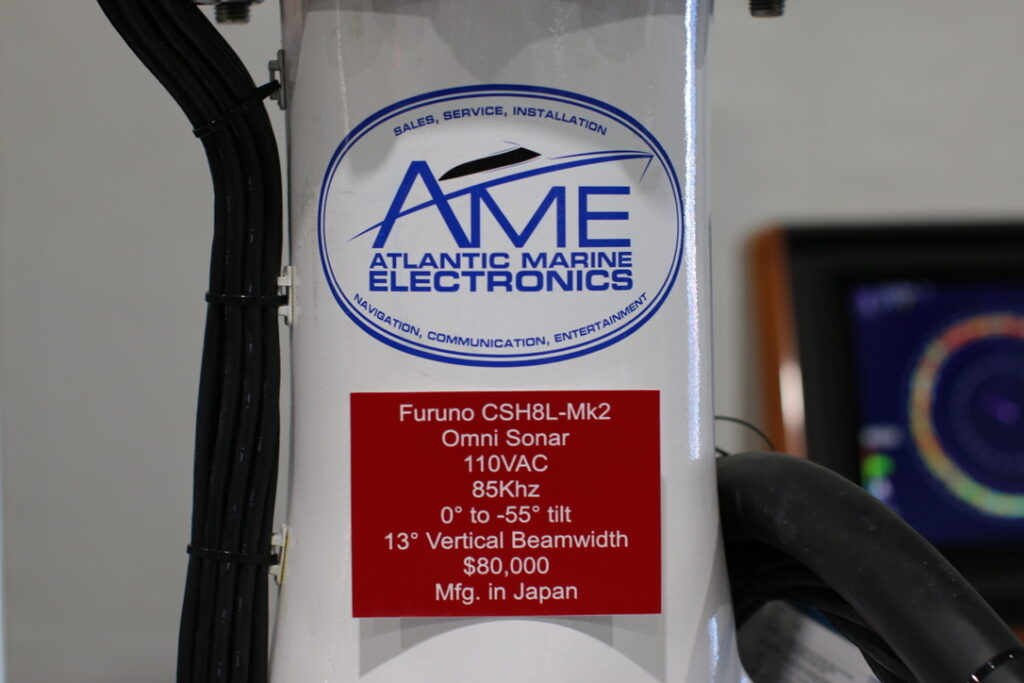
Furuno
Furuno continues to offer the most popular Omni style sonar installed in sportfishing boats. The term Omni refers to the ability of the sonar to scan the water in a 360-degree circle without moving parts inside the sound dome and essentially producing a live view of the water under the boat. Furuno’s Omni model, the CSH8LMK2, is an eight-inch diameter sonar and comes in two travel lengths: 400mm and 600mm. The 400mm is typically used for installations where the tank (fiberglass tube) is installed in the keel. The 600mm travel is for installation where the tank is located off center of the keel and therefore needs to extend farther into the water so that the sonar signal is not blocked by the keel.
How much room do you need for a Furuno CSH8LMK2 Omni? For a 400mm sonar, the tank (fiberglass tube) has a recommended minimum length of 24 inches and the 600mm tank has a minimum recommended length of 32 inches. The hoist is the main component inside the boat and is mounted to the top of the tank flange. It has a minimum recommended height of 30 inches for a 400mm tank and 36 inches for 600mm tanks. Additional clearance is desired, especially to access the manual hoist raising fitting.
The CSH8LMK2 is sold as a complete package, including a motion stabilizer with an optional handheld remote. This sonar is available in one frequency, 85 kHz, which works well for sportfishing. While today’s CSH8LMK2 is hard to beat, it’s rumored that Furuno is already working on the next generation of Omni sonars.
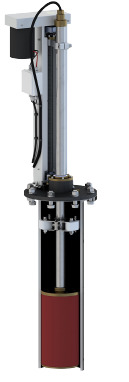
Simrad Norway
Kongsberg Maritime (Simrad Norway) has recently introduced the Simrad SY50, an eight-inch adjustable frequency Omni sonar. This new Omni sonar has a few innovations that have not yet been available on other units and is the smallest sonar from Simrad Norway.
One innovative design feature is that the transceiver electronics have been built inside the transducer housing, eliminating the traditional large transceiver box typically installed in or near the engine room. A stabilizing system is included for electronic pitch and roll compensation and is built into the transducer housing. It is expected to provide excellent stabilization in rougher water. The SY50 operates at a lower frequency than the Furuno, with a midpoint of 57 kHz but adjusts lower or higher from 54 to 60 kHz in steps of 0.5 kHz. Besides an expected longer range due to the lower frequency, the big advantage of the adjustable frequency is that interference from other boats’ sonar systems on the same frequency can be eliminated by adjusting your system away from neighboring boats’ frequency.
As many of you with the Furuno CSH8LMK2 have learned, nearby boats with the same model and frequency sonar can create interference in the received sonar images on both boats. The SY50 is a good fit for boats with limited space due to the reduced number of components. The communication between the hull unit and the computer on the bridge is limited to a single Ethernet cable. Both the hull unit and the computer can operate on DC power, whereas most other Omni sonars require AC power. No large computer boxes in the engine room or helm and a compact helm control keypad allows for SY50 installations in boats that can’t fit a traditional Omni sonar.
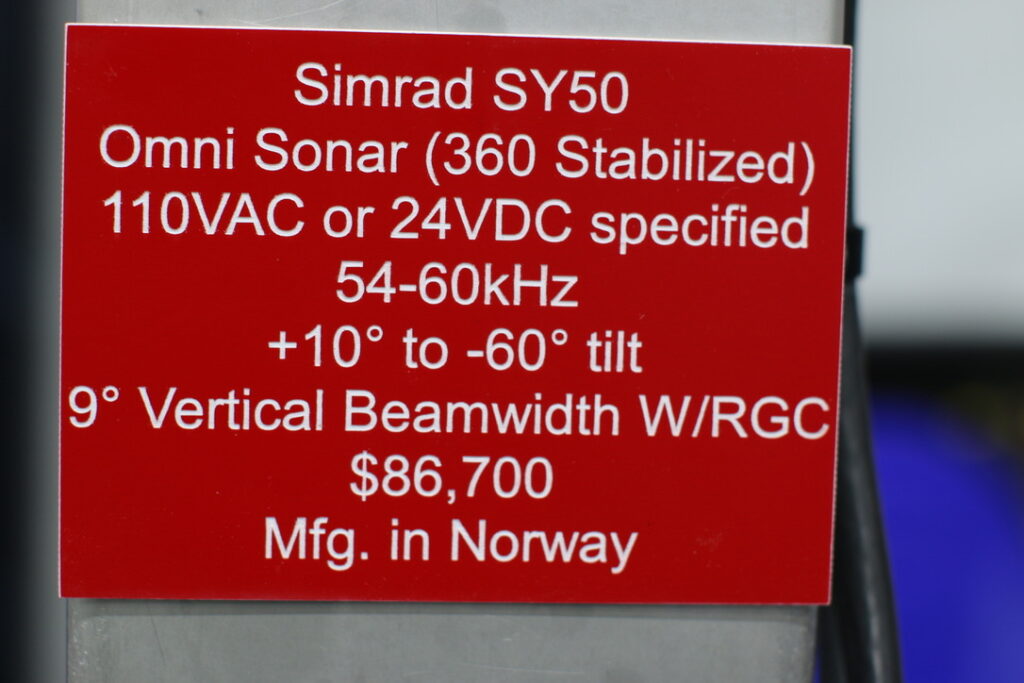
Koden
The Koden six-inch KDS-6000BB and eight-inch KDS-8000BB are the world’s first Broadband searchlight sonars. This is a searchlight sonar that incorporates a transducer inside a sound dome that rotates to cover the programmed area, up to a 360-degree circle. Due to the time it takes the moving transducer to scan the water, the picture is not quite live like an Omni. However, it does a good job of presenting a detailed view of the water under the boat.
These KDS sonars have an adjustable frequency range — originally 130 to 210 kHz with a recently introduced 80 to 90 kHz frequency — chosen at the time of purchase. As with traditional sounders, the lower frequency units have a longer range than the higher frequency. The KDS sonars operate on 12v or 24v DC, and do not have a large transceiver box, just a compact processor mounted near the helm. The KDS units have an adjustable travel length, allowing for a tank length as short as 26 inches and a hoist height above the tank flange as short as 16 inches for a more compact throw unit. These features, along with the smaller six-inch diameter unit make it a good fit for center consoles and smaller boats that don’t have available height in the machinery spaces.
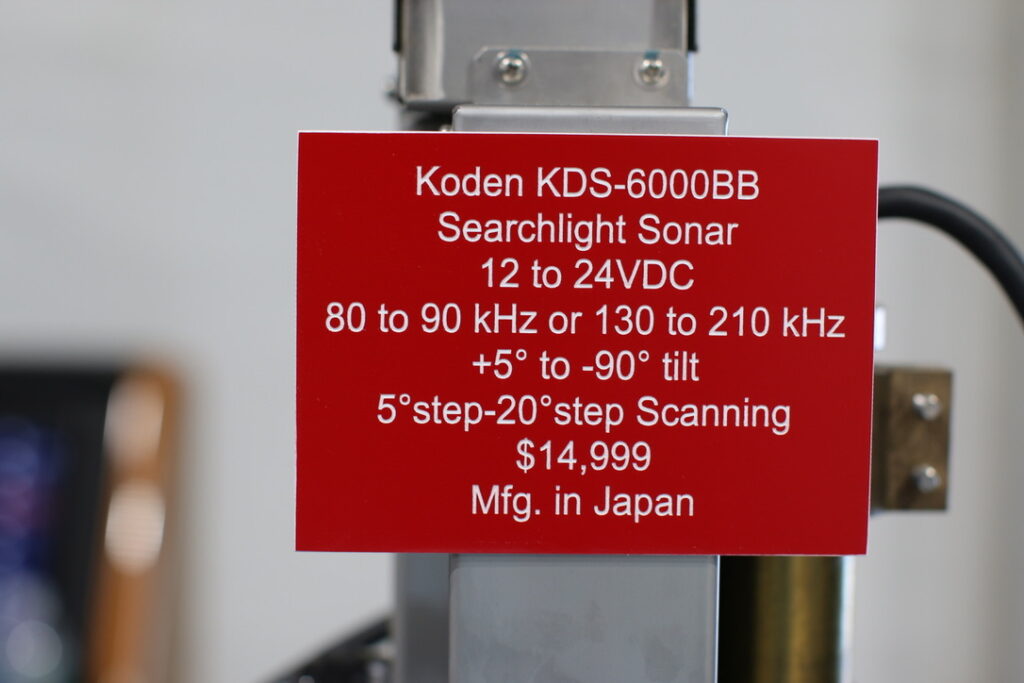
JRC (Japan Radio Company)
JRC is a Japanese company founded in 1915 as a communications technology company, specializing in commercial marine equipment and is best known by pleasure boaters in the US for its radar systems.
Along with many commercial sounders, JRC manufactures sonars, including an eight-inch Omni sonar that fits into the same eight-inch tank (tube) as other popular eight inch sonars. The JFS-280 is a fully stabilized omni style sonar, with a variable beam angle and is made up of similar components — such as hoist, transceiver and processor — as other omni sonars. The JFS-280 is unique with its stainless-steel transducer housing, which reduces maintenance of the underwater components.
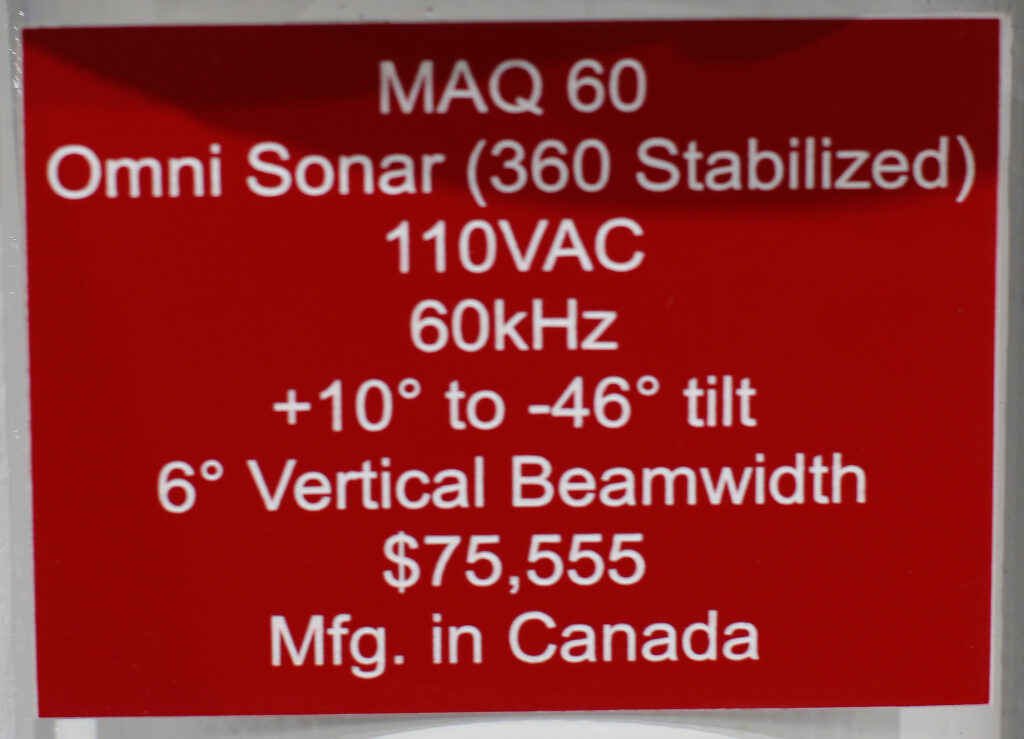
MAQ
While MAQ was not in attendance, it was represented by AME. In 1978, MAQ Sonar designed and built the first Omni Sonar for the commercial fishing industry. Their current products for sportfishing are an eight-inch Omni sonar, available in two different frequencies, MAQ 90, MAQ 60. The MAQ requires slightly more room on board than the Furuno while the MAQ tank (fiberglass tube) has a recommended minimum length of 38 inches and the hoist has a minimum recommended height of 40 inches. The rest of the components of the MAQ are similar to the Furuno CSH8LMK2, such as the transceiver, processor and control keypad. AME is currently testing the MAQ sonar on a Viking.
Wesmar
Not in attendance but worth mentioning, Western Marine Electronics (Wesmar) has been around since 1965 and manufactures a wide variety of commercial marine systems, such as thrusters, stabilizers, navigational sonars and fishing sonars. This equipment is made near Seattle, WA. They offer a dozen models of searchlight sonar in six inches, eight inches and 10 inches, all with a variety of frequencies and power sources.
Real World Takeaway From the Panelists at the NMEA Event
Choose an experienced boat yard and fiberglass company to install the tank (tube) into the hull. Most of these units require an eight-and-a-half-inch diameter hole cut into the hull to accommodate the supplied fiberglass tank. The tank needs to be installed in a location that provides for the best performance based on the underwater design of the boat with working access to install and service the mechanical parts of the sonar system mounted on top of the tank. While each installation is different, most sonar manufactures recommend incorporating bracing for the tank to keep it rigid with the hull structure. Additionally, the fairing or fairwater where the sonar tube exits the hull is extremely important to the performance of the sonar both when running with the unit retracted and when trolling with the sonar deployed.
Vents
Some boats seem to trap air inside the sonar tank, above the retractable sound dome. This can affect the ability to raise the sonar and can create interference in the sonar image due to air bubbles streaming out from the tank. Boats that operate at high speeds may need to vent the buildup of air and water forced into the sonar tank. In situations like this, the installation of an air vent valve at the top of the sonar tank may be a good idea, the termination of this vent is installed above the waterline and possibly plumbed directly overboard. This system includes a valve at the top of the sonar tank to be opened manually to expel trapped air as needed.
Tanks or Tubes
Most of the popular sonar manufactures adhere to a standardized diameter and mounting flange bolt pattern. The popular eight-inch sonar offerings from the manufacturers above all use the same tank size allowing a boat owner to install or swap sonar brands without changing the structural sonar tank. Additionally, a sleeve kit is offered to install a six-inch sonar into an eight-inch tank. The sleeve kit could be a good way to prepare for the future. Installation of an eight-inch tank with a six-inch sleeve allows a less expensive searchlight sonar to be installed while making it possible to install a larger eight-inch sonar in the future without incurring the cost of removing the six-inch tank and installing an eight-inch tank.
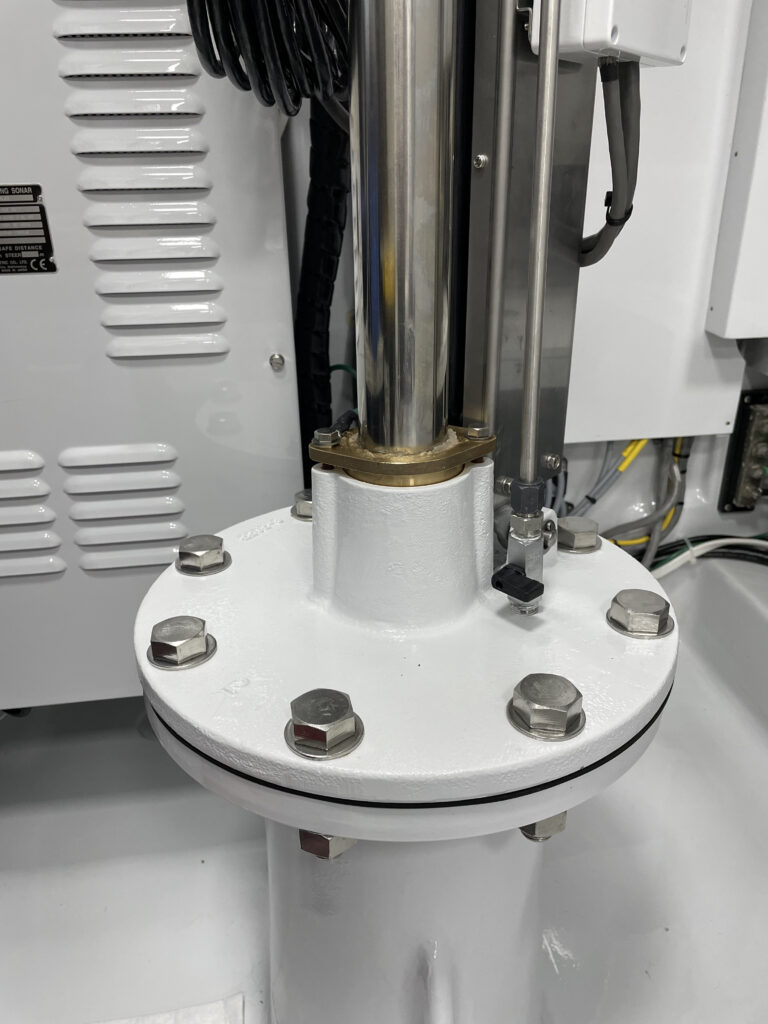
Sea Trial After Installation
The marine electronics installer should perform a sea trial with the captain to confirm proper operation of the equipment. The sonar should be interfaced with the boat’s GPS to provide speed and heading at a minimum. The speed input is used to automatically retract the sonar after a predetermined speed, such as 12 knots or similar, to avoid hardware damage at higher speeds. This feature should be tested during a sea trial. The sonar directional aiming should be confirmed using a fixed object, such as a buoy, pier or even a deployed target. This assures that the sonar transducer is properly oriented with the bow of the boat.

An eight-inch diameter slug skillfully cut from the keel
for the sonar retraction tank.
Settings
Sportfish boats travel to many fishing grounds throughout the year. The settings of your sonar will vary depending on where you are fishing, especially due to the salinity of the water — the lower the salinity the better the performance. The sea water temperature and thermoclines can affect the performance of your sonar. Air temperature and sunlight can heat and cool the surface water to varying depths of the ocean, and as cool water meets warm water a thermocline layer is formed. A thermocline can have the effect of refracting the Sonar beam and reducing the detection distance. Rain can affect the reflected sonar transmission since it causes surface noise much like boat wakes and prop wash. Learning your unit’s settings is important to allow you to make adjustments quickly as environmental conditions change.
Preventative Maintenance
Now that some boats have had sonars for a few years, preventative maintenance should be performed whenever the boat is hauled out of the water, or sooner if needed. While each manufacturer has specific maintenance guidelines, here are a few generic tips for when the boat is hauled out on land:
● Lower the sound dome and check for damage, marine growth, tightness of fasteners, shaft condition, tank guides and especially check the condition of the Zinc (sacrificial anode) if equipped — replace as needed.
● Inspect for marine growth inside of the sonar tank, excessive growth can cause problems raising or lowering the sonar.
● Inside the boat, check the shaft packing and replace if needed, along with greasing the moving parts and checking the condition of the cabling and associated hardware and connections.
These sonars are sold and installed by experienced marine electronics companies who may customize the installation based on their experience for each boat. The same goes for the fiberglass work needed and selecting the proper location to install the tank securely in an area for best sonar performance and ease of service. If you are in the market for a new sonar or an upgrade of your legacy equipment the options are many and the base of skilled marine electronics dealers is expanding.
Supply Chain Update
Despite back orders and order delays for many products, the marine electronics industry has been getting by with limited supply and creative compromises. Until the late summer of 2021, the availability of the Furuno CHS8LMK2 Omni sonar was on par with other years and shortages were demand-based. At the end of the summer, Furuno announced raw material shortages were delaying the manufacturing of the popular CHS8LMK2 at least until spring While this delay has forced many boat owners to put their sonar project on hold, you can still make progress in installing an Omni sonar.
The industry standard eight-inch fiberglass tube (tank) and watertight sealing cap kit are currently available. If you already have your yard time scheduled, you can continue and install the sonar tube and cap it. Once a sonar is available, you can haul the boat and install the underwater components in short order. Additionally, since the eight-inch tube is universal with popular sonars, you can install another brand on your boat if you can’t wait for the Furuno CHS8LMK2.
Don’t Forget to Check Out Our Sportfishing Job Board! Did You Know? It’s the perfect platform for seeking skilled captains and mates. Whether you’re on the hunt for your dream team or looking to join one, your next big adventure begins here. Explore the opportunities now! Click Here
Dive Deeper into the World of Sportfishing
Unlock Exclusive Savings: Enjoy 50% Off Your Subscription!
Are you ready to explore the thrilling world of sportfishing from the comfort of your home? Subscribe now and embark on a journey filled with captivating stories, expert insights, and insider tips. Choose between our digital or print edition and secure an incredible 50% discount on your subscription.
Subscribe today and get ready for an adventure like no other. Click here to subscribe and elevate your sportfishing experience with InTheBite Sportfishing Magazine.







